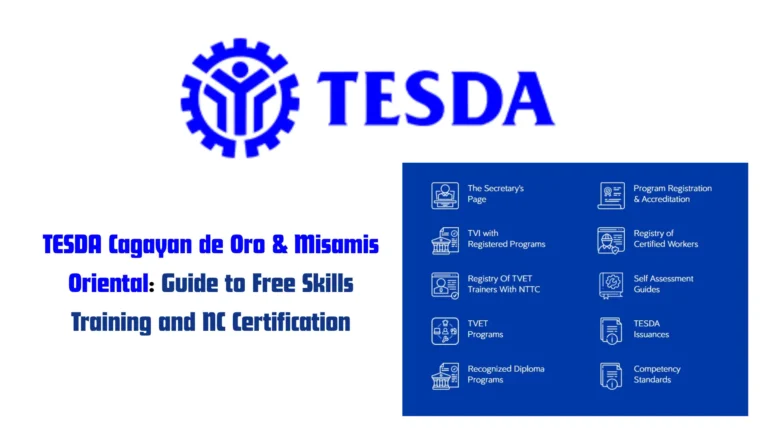Vocational Training in the Philippines: Mastering Skills at the RTC Calabarzon and Beyond
In the bustling economic landscape of the Philippines, the Calabarzon region (Cavite, Laguna, Batangas, Rizal, Quezon) stands as a powerful industrial and technological hub. Fueling this growth is a skilled workforce, meticulously trained and certified to meet the exacting demands of local and international industries. At the forefront of this mission is the Regional Training Center Calabarzon (RTC Calabarzon), a premier institution dedicated to delivering world-class vocational training in the Philippines.
For many aspiring technicians, chefs, welders, and IT professionals, the search for quality training leads them to a simple but crucial question: what is the RTC Calabarzon and how can it serve as a launchpad for my career? This pillar page is designed to be the definitive answer. We will explore the pivotal role of vocational training in the national economy, delve into the specific offerings and advantages of the Regional Training Center Calabarzon, and provide a practical guide on how you can become part of its next generation of skilled graduates.
Understanding the ecosystem of vocational training in the Philippines, particularly through flagship institutions like RTCs, is the first step toward securing a stable, rewarding, and future-proof career. This guide will navigate you through the opportunities, the processes, and the profound impact that a quality technical education can have on your professional journey.
The Bedrock of Progress: Understanding Vocational Training in the Philippines
Vocational training, also synonymous with Technical-Vocational Education and Training (TVET), is an educational pathway that prepares individuals for specific trades, crafts, and careers at various levels. It is learning that is directly applicable to a job, emphasizing practical skills over theoretical knowledge.
Why is it so critical?
- Bridging the Skills Gap: It directly addresses the mismatch between the skills job seekers possess and the skills employers need.
- Economic Mobility: It provides a relatively fast and affordable route to gainful employment and entrepreneurship for a significant portion of the population.
- Industry Responsiveness: TVET programs are designed in close consultation with industry leaders, ensuring that graduates possess relevant and up-to-date competencies.
- Global Competitiveness: Philippine National Certificates (NC) are recognized internationally, opening doors for overseas employment.
The Philippine TVET system is primarily managed by the Technical Education and Skills Development Authority (TESDA), which oversees a network of institutions, including the highly regarded Regional Training Centers (RTCs).
The Crown Jewel of Region IV-A: Unveiling the Regional Training Center Calabarzon (RTC Calabarzon)
A Regional Training Center (RTC) is a TESDA-administered training institution that serves as a model for technical-vocational education in its region. It is characterized by its:
- High-Quality Standards: RTCs are equipped with state-of-the-art facilities and tools that mirror actual industry work environments.
- Expert Trainers: Trainers are typically industry experts with advanced qualifications and a passion for teaching.
- Industry-Linked Curriculum: Courses are aligned with the latest Training Regulations (TRs) developed by TESDA in partnership with industry sectors.
- Center of Excellence: RTCs often specialize in high-demand trades and serve as a assessment center and a hub for trainer’s training.
The RTC Calabarzon embodies all these qualities. It functions as the flagship training delivery arm of TESDA in the Calabarzon region, setting the benchmark for quality and innovation in vocational training in the Philippines.
The Strategic Advantage of Training at RTC Calabarzon
Choosing to train at the Regional Training Center Calabarzon offers distinct benefits over other institutions:
- Assured Quality and Compliance: As a TESDA-run center, there is an absolute guarantee that the training delivered strictly follows the competency standards set by the agency. You are learning the right skills, the right way.
- Access to Modern Facilities: RTCs are prioritized for government funding, meaning they often have the newest equipment, tools, and模拟 (mónǐ) – simulation laboratories for trainees to practice on. This provides an unparalleled hands-on experience.
- Scholarship Opportunities: A significant number of training slots at RTCs are covered by TESDA scholarship programs like the Training for Work Scholarship Program (TWSP), meaning eligible students can train for free and even receive a stipend.
- Strong Industry Connections: RTCs have established pipelines to industry partners for on-the-job training (OJT) and job placement. Employers actively seek out graduates from RTCs because of their reputation for excellence.
- Comprehensive Training Pathway: From the theoretical foundations to the advanced practical applications and culminating in the competency assessment, the RTC provides a seamless and integrated learning journey.
A Glimpse into the Course Offerings at RTC Calabarzon
While the exact course catalog may evolve based on industry demands, RTCs typically offer programs in sectors that are critical to the regional economy. The Regional Training Center Calabarzon is known to offer courses in high-demand fields such as:
- Information and Communication Technology (ICT):
- Computer Programming
- Animation NC III
- Visual Graphic Design NC III
- Tourism and Hospitality:
- Cookery NC II
- Bread and Pastry Production NC II
- Food and Beverage Services NC II
- Housekeeping NC II
- Industrial and Construction Trades:
- Electrical Installation and Maintenance (EIM) NC II and NC III
- Shielded Metal Arc Welding (SMAW) NC I and NC II
- Automotive Servicing NC I and NC II
- Other Emerging Fields:
- Caregiving NC II
- Beauty Care Services NC II
Prospective students must contact RTC Calabarzon directly for the most current and complete list of offered courses, schedules, and availability.
The Road to Enrollment: How to Train at RTC Calabarzon
The process to become a trainee at the Regional Training Center Calabarzon is straightforward but requires attention to detail.
Step 1: Inquire and Research
- Identify Your Course: Based on your interest and market demand, choose a course offered by the RTC.
- Contact RTC Calabarzon: Find the official contact information (phone number, email, social media page) for the center. The best source is the official TESDA website or the TESDA Calabarzon regional office.
- Ask Crucial Questions: Inquire about the next available training schedule, the specific requirements for enrollment, and the availability of scholarship slots.
Step 2: Prepare the Requirements
The standard TESDA requirements for enrollment generally include:
- A duly accomplished application form
- Original and photocopy of your Birth Certificate (PSA)
- Original and photocopy of your High School or College Diploma
- Latest 1×1 ID pictures
- A valid Government-Issued ID
- Other course-specific documents (e.g., a medical certificate for caregiving or cookery)
Step 3: Submit Your Application and Enroll
- Submit your complete documents to the administration office of RTC Calabarzon on or before the announced deadline.
- If applying for a scholarship, ensure you meet the criteria and submit any additional proof of eligibility (e.g., barangay certificate of indigency).
- Once accepted, you will be given an enrollment date and a schedule of classes.
Step 4: Undergo Training and Assessment
- Attend classes diligently and complete the required training hours.
- Demonstrate competency in all required modules.
- Schedule and take the National Competency Assessment to earn your NC or COC.
Beyond RTC Calabarzon: The Wider TVET Ecosystem
While RTCs are excellent, they are one part of a vast network. The vocational training in the Philippines landscape also includes:
- Provincial Training Centers (PTCs): Located in provincial capitals, offering similar quality training.
- TESDA-Accredited Private Technical Vocational Institutions (TVIs): Thousands of private schools offer TESDA-registered programs.
- Enterprise-Based Training: Programs conducted within companies for their employees.
- Community-Based Training: TESDA brings training directly to barangays for specific, short-term skills.
Frequently Asked Questions (FAQ)
Q: Is training at RTC Calabarzon free?
A: Training is often free for scholars under programs like TWSP. For non-scholars, there is a minimal training fee. However, the cost at an RTC is typically much lower than at private institutions for the same quality of training. Always inquire about scholarship availability.
Q: How long do the courses at RTC Calabarzon take?
A: Course duration varies significantly. Short courses can be 2-3 weeks, while comprehensive programs like Caregiving NC II or Programming can take 3 to 6 months. The specific duration will be provided in the course curriculum.
Q: Can I get a job immediately after graduating from RTC Calabarzon?
A: While no institution can guarantee employment, graduates from RTCs have a very high employment rate due to the quality of training and the center’s industry connections. The NC certificate you earn is a powerful credential valued by employers.
Q: What is the difference between an RTC and a private TESDA-accredited school?
A: The main difference is administration and resources. RTCs are government-run and often have the latest equipment. Private TVIs are businesses that must meet TESDA standards. Both can provide excellent training, but RTCs are generally considered the benchmark for quality.
Q: How can I find the contact details for RTC Calabarzon?
A: The best way is to visit the official TESDA website (www.tesda.gov.ph) and navigate to the directory for Regional Training Centers, or contact the TESDA Calabarzon Regional Office directly for guidance.
Conclusion: Your Future, Crafted with Skill
The choice to pursue vocational training in the Philippines is an investment in a future built on tangible, in-demand skills. It is a decision to become the architect of your own economic destiny. Within this ecosystem, the Regional Training Center Calabarzon (RTC Calabarzon) stands as a beacon of excellence, offering a direct pathway to mastery in your chosen trade.
By choosing an RTC, you are not just enrolling in a course; you are immersing yourself in an environment designed for your success. You gain access to top-tier facilities, learn from master trainers, and become part of a network that connects directly to the world of work.
Take the knowledge from this guide—from understanding the value of TVET to the specific steps for enrolling at RTC Calabarzon—and transform it into action. Identify your passion, reach out to the center, and take that first decisive step toward earning your National Certificate. Your journey to becoming a highly skilled, certified, and sought-after professional in the vibrant Calabarzon region begins with a single inquiry.







